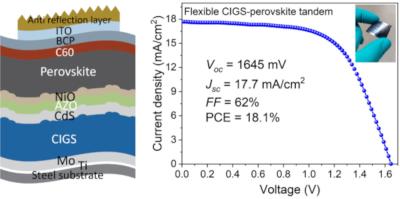Researchers at the University of Sydney, Microsolar, University of New South Wales and MiaSolé Hi-Tech Corp. have reported a monolithic perovskite–CIGS tandem solar cell on a flexible conductive steel substrate with an efficiency of 18.1%, the highest for a flexible perovskite–CIGS tandem to date, representing an important step toward flexible perovskite-based tandem photovoltaics.
The advantage of the flexible and conductive steel substrate is that the steel itself can act as both a substrate and an electrode for either large-area-monolithic-panel or smaller-area-singular single-junction or multi-junction cell fabrication.
The new cell is an evolution of a 17.1%-efficient perovskite device that another research group of the University of Sidney presented in August.
The research group built the cell with a 50 μm thick steel substrate coated with molybdenum (Mo), a CIGS absorber, a cadmium sulfide (CdS) window layer, transparent conductive oxide films made of aluminum-doped zinc oxide (AZO), a hole transport layer (HTL) based on nickel(II) oxide (NiO), a perovskite absorber, an electron transport layer (ETL) relying on buckminsterfullerene (C60), a spacer based on phenyl-C61-butyric acid (PCB), an indium tin oxide (ITO) layer, and an anti-reflection layer.
The scientists deposited the perovskite layer perovskite layer via thermal evaporation and spin coating. “As the substrate used is conductive, metal contact with the rear side of the CIGS bottom cell can be made on either side of the substrate, allowing flexibility for cell interconnection,” they explained.
Tested under standard illumination conditions, the tandem cell achieved a power conversion efficiency of 18.1%, an open-circuit voltage of 1,645 mV, a short-circuit current density of 17.7 mA/cm2, and a fill factor of 62%. This result represents the highest efficiency ever reported to date for a flexible perovskite-CIGS tandem solar cell.
“The substrate used has an added advantage of being conductive, allowing metal contact to be made on either side,” the team said. “Physical deposition proves to be effective in overcoming the unique challenges associated with irregular surfaces of CIGS cells for tandem demonstrations.”




